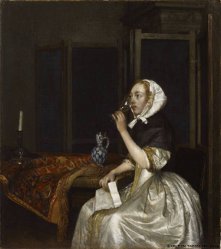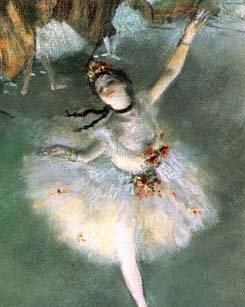
Up early to Trafalgar Square (8:30) and thinking maybe, just maybe, I'll be able to get in and see the Leonardo exhibition on at the National Gallery, Painter at the Court of Milan. Sadly, it was not to be.
Turning the corner and seeing a very long queue snaking around the building made me snap back to reality. I half-heartedly joined the end and waited a few minutes. However, some staff were walking down the queue saying that there were "no tickets" and that we would not get in, so I gave up and went to the Wallace Collection again instead. I might try Leonardo one more time in January.
In the meantime, the Wallace is a great collection of lots of stuff. Including paintings, furniture, porcelain, ceramics and medieval armour. A particular emphasis on pre-revolution French art.
Portrait of Madame Perregaux, Elizabeth-Louise Vigée Le Brun (18th C)
Madame Perregaux was reportedly very pleased with this portrait because it was very flattering. I like it as well, the eyes are almost twinkling.

Detail from Standing Bowl: Lucretia. Urbino District, Mid-16th Century

There are some wonderful pictures on display in the exhibition taking place at the Fitzwilliam Museum in Cambridge, Vermeer's Women. Not all of them by Jan Vermeer himself.
Although Jan Vermeer is one of the best known of the Dutch 17th Century masters, some of the others here are also amazingly good, even painting similar subjects. For example: Pieter de Hooch and Gerard ter Borch.


Right: Pieter de Hooch, The Courtyard of a House in Delft c.1658
There's a 10 minute discussion about the exhibition on You Tube :
You Tube hosts many interesting videos on these artists, including Vermeer's Milk Maid.
How great is YouTube?
As well as being a superb resource for recipes (great for cooks lacking confidence), I've also found out how good it is for watching artists work. It's truly fascinating watching the creative process.
For instance, Scott Waddell produces extremely fine oil paintings, with a very high level of detail and meticulous painting. If you look at his Webisode 3: Imagining a Composition , the artist he made me think of was Théodore Géricault, specifically for his Raft of the Medusa. Watching him preview a portrait is amazing :
Another couple of equally talented artists :
The new resources we have nowadays should revolutionise education. Where is the revolution?

When you step into L. Cornelissen & Son, it's like stepping back in time.
The shop's not large, but full of everything an artist might want: with floor to ceiling shelves, cupboards and drawers, all in a dark wood.
To top it off though, and what makes that extra difference in any shop, is the helpfulness and knowledge of the staff. Someone I can only assume was Mr Cornelissen senior, took time to help and educate me on a number of things I wanted to buy, including brushes, paint and medium. It's the personal touch that has all but vanished in many places, and one of the reasons I'll go back.
The shop is on Great Russell Street, on your way to the British Museum : map
I went to the RA a couple of weeks ago on a Sunday afternoon for the Degas and the Ballet: Picturing Movement show.
It costs money, and there was a queue, but knowing the sorts of queues for the National Gallery's Leonardo exhibition, one can't complain (it only took about 20 minutes to get in).
Inside, it really was very low lighting: dim, in fact. I was told that this was to protect the pieces, but I'm not sure if this referred to the photographic pieces or the paintings. I thought it a bit of a shame though. It was also quite busy (see: queue), which meant that seeing everything was a bit trying on occasion. It was worth it though.

His style of painting is one of the attractions. He captures movement very well and his brush strokes often take on an almost pastel stick quality, something unique to him (he was also a master pastel artist). His sense of light and shade, especially from the large rehearsal room windows or stage lights, was also masterful.
Photosculpture : Bullet Time in the 19th Century
The show was subtitled Picturing Movement and the theme was a comparison of the art of Degas and the new art form of photography. A lot of the exhibition was devoted to the display of historical artifacts related to both the still photograph and its successors. Not just the moving image but such things as the photo-sculpture, a form of photography that involved taking dozens of simultaneous pictures, with cameras arranged in a circle around the subject. I was very surprised to see this technique over a hundred years before The Matrix!
A good show. I just wish that they a) turned the lights up a bit and b) allowed (non-flash) photography inside.
As is often the case, Wikipedia has a good page on Degas.
I saw this at the British Museum the other week. It's very striking.
"During the Roman Period in Egypt, the tradition of providing an eternal image of the deceased over the head of the mummy was maintained in a variety of forms, including panel-portraits, paintings on shrouds, cartonnage masks and moulded plaster heads."
about AD 100-170 from Hu (Diospolis Parva).

Beddingham Hill
I've been to quite a few shows in many big museums and galleries this year, but easily forget that there are a lot more smaller, private galleries around, often with very interesting and appealing art in them. If I have time, I've made a special effort to pop in if I pass one, if it doesn't look too intimidating.
A few months ago I had a great look around the Francis Kyle gallery. The exhibition was called This Twittering World and featured art inspired by T.S. Elliot's Four Quartets.
Passing by, I saw something amazing through the window and had to have a look. The two staff that showed me around some of it (including paintings not on display) were wonderful. This sort of thing does not happen at the National Gallery, or any of the larger galleries in general.
In the end though, the artist that struck me most here was Jonathan Briggs. Beautiful and serene paintings of idyllic English landscapes. I love these. I would love to own one.
At the weekend, I looked at the Winter Collective exhibition at the gallery Different in Percy Street. Like the Francis Kyle visit, it was the sight of very arresting paintings that drew me in, in this case the large and unsettling oil paintings by Johan Andersson.
These are very well executed but not something I would hang on my wall in general. Apart from the subject matter being dark and disturbing, they're very large. The oil painting is beautifully done however and I cannot complain too much because the subject matter (stumps, scars and acid victim) is not far removed from some of my own dabblings many years ago.
One thing you do start to notice is how much each individual work goes for. From a a few hundred (small, screen print style) to many thousands. If paper money starts to seriously lose its store of value, then many people see art as an alternative investment. Maybe wisely.



